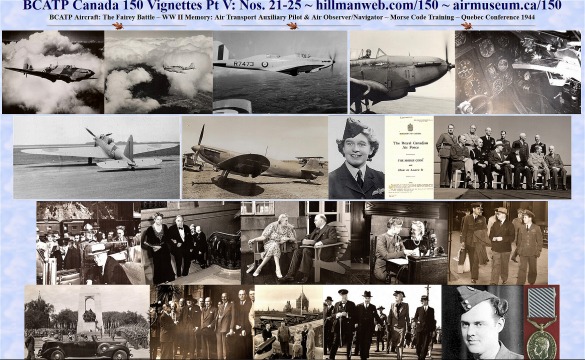022 of
150
A World War II Memory: Mary Ellis - Air Transport
Auxiliary Pilot
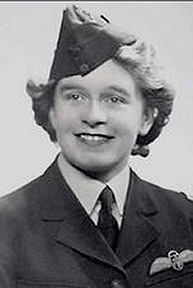 A
wonderful newspaper article in Britain’s The Mail on Sunday was brought
to our attention by Commonwealth Air Training Plan Museum charter member
John Robinson. It is the story of Mary Ellis, a veteran of the World War
II’s Air Transport Auxiliary, who celebrated her 100th birthday earlier
this year. The Mail on Sunday relayed her story and a video of her taking
control of a Spitfire aircraft, flying in formation with one she had flown
in WWII, over West Sussex in October of 2016. The complete story can be
seen at:
A
wonderful newspaper article in Britain’s The Mail on Sunday was brought
to our attention by Commonwealth Air Training Plan Museum charter member
John Robinson. It is the story of Mary Ellis, a veteran of the World War
II’s Air Transport Auxiliary, who celebrated her 100th birthday earlier
this year. The Mail on Sunday relayed her story and a video of her taking
control of a Spitfire aircraft, flying in formation with one she had flown
in WWII, over West Sussex in October of 2016. The complete story can be
seen at:
http://www.mailonsunday.co.uk/news/article-4191976/Woman-flew-spitfires-WWII-celebrates-100th.html
A comprehensive accounting of the Air Transport Auxiliary
is available from Wikipedia at from which the following excerpts are offered
below.
The Air Transport Auxiliary was set up in the United
Kingdom in February 1940 with the primary objective of providing working
aircraft to the Royal Air Force. In doing so, the ATA ferried new, repaired
and damaged military aircraft between various destinations for deployment
by the RAF and manufacturing, repair or scraping locations. The ATA also
provided some air ambulance services and ferrying of service personnel
from one place to another. The ATA worked out of 14 ferry pools dispersed
throughout Britain. The organization also had an Air Movement Flight Unit
and two training units. Personnel included 1,152 male pilots and 166 female
pilots, 151 flight engineers, 19 radio officers, 27 cadets and 2786 ground
staff. By 1943, the women’s pay was equal to that of the men.
In World War II, the Air Transport Auxiliary flew 415,000
hours and delivered 309,000 aircraft to various locations. These numbers
include 147 types of aircraft including Spitfires, Hurricanes, Mosquitoes,
Lancasters, Halifaxes and Flying Fortresses. About 883 tons of freight
was carried and 3,430 passengers were transported without any casualties.
One hundred and seventy-four male and female pilots were killed flying
for the ATA.
As a civilian organization under the control of the Ministry
of Aircraft Production, the ATA relied on pilots who were not suitable
for the Royal Air Force or Fleet Air Arm service because of age or physical
fitness. Other pilots were recruited from 28 neutral countries.
Women from Britain, Canada, Australia, New Zealand, South
Africa, the United States, the Netherlands Argentina, Chile and Poland
were accepted into the ATA. Fifteen women lost their lives while flying
for the ATA. The women were initially restricted to trainers and transports
but went on to fly all types of aircraft used by the RAF and Fleet Air
Arm with the exception of the largest flying boats.
Although the ATA was a civilian organization, personnel
wore uniforms and pilots were given ranks equivalent to RAF ranks. These
were
ATA Senior Commander – RAF Group Captain
ATA Flight Captain – RAF Squadron Leader
ATA First Officer – RAF Flight Lieutenant
ATA Second Officer – RAF Flying Officer
ATA Third Officer – RAF Pilot Officer
The great contributions of the men and women of the ATA,
of which the release of eligible men to service in the RAF and Fleet
Air Arm was their biggest victory, surely helped to hasten the Allied victory
of World War II.
Wikipedia – Air Transport Auxiliary https://en.wikipedia.org/wiki/Air_Transport_Auxiliary
023 of
150
BCATP: Training -- The Morse Code
This eight page pamphet was received
at the Commonwealth Air Training Plan Museum in June 2015. In World War
II, It was given to potential RCAF air crew students in the Manning Depots
to give them a jump on one of the subjects they would need to learn in
advanced training. Admittedly, the Morse Code is a somewhat dry subject
but a read of the text translation below will definitely provide some intersting
points about the techniques and philosophy of Morse Code usage, an invaluable
communication skill required for aerial combat.
AIR FORCE PAMPHLET No. 11
(August, 1941)
DOMINION OF CANADA
The Royal Canadian Air Force
THE MORSE CODE And How to Learn It
NO'l'E
This pamphlet is issued to all recruits on posting to
Manning Depots for training as pilots, observers and wireless operators
(air gunner). Its object is to allow men to get a start with the Code in
the correct system prior to their courses of instruction. Use this continually
and bring it with you when you are transferred to an Initial Training or
Wireless School.
(Based on RAAF. Publication No. 81)
30:\1- 3-42 (1787)
H.Q. 560-11
THE MORSE CODE
INTRODUCTION
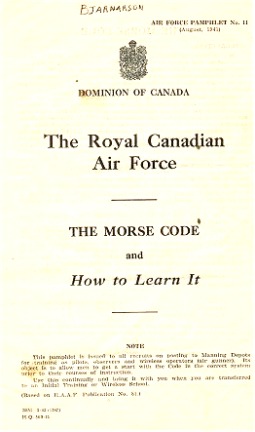 In
1836, Samuel Morse, an American, introduced the code system which bears
his name, and the first message by using the "Morse Code" was sent by telegraph
from Washington to Baltimore in 1844. The introduction of the Morse Code
was a tremendous advance in signalling, since it meant that communication
was no longer restricted to persons within sight of each other, but messages
could now be sent day or night over long distances. Although the code invented
by Morse was satisfactory for telegraph work certain difficulties were
encountered with the rapid: advance of radio or wireless telegraph as it
was called and at a convention in London in 1912 a new code was introduced,
known as the "International Morse Code". This covers all the languages
that use the Roman alphabet-English, French, German, Spanish, etc. The
"International Morse Code" is the code used in the R.C.A.F. for signalling
by means of wireless telegraphy. The international Morse Code can also
be used to signal by visual means (Aldis lamps) and by sound (Klaxon horns
for use in fog).
In
1836, Samuel Morse, an American, introduced the code system which bears
his name, and the first message by using the "Morse Code" was sent by telegraph
from Washington to Baltimore in 1844. The introduction of the Morse Code
was a tremendous advance in signalling, since it meant that communication
was no longer restricted to persons within sight of each other, but messages
could now be sent day or night over long distances. Although the code invented
by Morse was satisfactory for telegraph work certain difficulties were
encountered with the rapid: advance of radio or wireless telegraph as it
was called and at a convention in London in 1912 a new code was introduced,
known as the "International Morse Code". This covers all the languages
that use the Roman alphabet-English, French, German, Spanish, etc. The
"International Morse Code" is the code used in the R.C.A.F. for signalling
by means of wireless telegraphy. The international Morse Code can also
be used to signal by visual means (Aldis lamps) and by sound (Klaxon horns
for use in fog).
The International Morse Code (which from now on we will
refer to as simply the Morse Code) is based on two types of signals which
differ in the time taken to make them, namely a short signal and a long
one, called respectively a dot and a dash. Letters, numerals and other
necessary signals are made up of various combinations of these dots and
dashes. The Morse Code has the advantage that, unlike the Semaphore Code,
It can be used with various types of signalling equipment which can be
selected to suit requirements. The use of this code provides a means of
signalling over short or long distances both by day and by night. In visual
signalling the dot and the dash may be represented by the exposure of a
light for short and long periods (The Aldis Lamp). In wireless telegraphy
the operator makes dots and dashes by pressing for short and long intervals
a key, which actuates some form of electrical circuit. At the receiving
instrument the dots and dashes may be reproduced by short and long buzzes
on a telephone receiver or by means of musical notes of short and long
duration representing the dots and dashes of the Morse Code.
A wireless operator depends for his job, on his knowledge
of Morse Code. The standards required of aircrew in the R.C.A.F. are:
-
Pilots – Aural 8 w.p.m. - Lamp 6 w.p.m.
-
Observers – Aural 8 w.p.m. – Lamp 6 w.p.m.
-
Wireless Air Gunners – Aural 18 w.p.m. – Lamp 6 w.p.m.
The standards given above are the minimum standards required
on completion of training. Higher standards are required on operational
units after practice.
THE CONSTRUCTION OF THE CODE
Morse is a "sound language". To an operator, Morse symbols
speak as clearly as the spoken word. It depends on rhythm for its operation,
and it is important that it be appreciated as rhythm from the start. It
is usually written on paper in "dots and dashes." This is for the sake
of convenience in writing it down. Unfortunately, most learners attempt
to memorize the code in this form, It is easy to learn, and they have no
trouble in reading Morse at slow speeds - say up to 8-10 words per minute.
The reason is this. At these slow speeds, it is easy to pick out the dots
and dashes, count them up, and compare them mentally with the Code as it
was learnt, sort out the letter intended, and write it down. This, of course,
is a long and involved process and requires a certain agility of mind.
At speeds greater than about 10 words per minute, the
above process unfortunately becomes impossible and the learner, working
on this system cannot cope with the higher speeds. However, as the speed
increases, the ear gradually adapts itself to the increase in speed and
change of sound and, over 15 w.p.m. it learns to recognize the letters
themselves as sounds and not as collections of dots and dashes. Nevertheless,
it goes through a continual process of readjustment as the speed changes.
The process after this is much simplified. The ear hears
a collection of dots and dashes as a definite sound. This immediately registers
itself as a letter and is written down automatically, often without the
writer being conscious o! what he has written. It is clear, then, that
the person who learns the code as sounds to start with, need not readjust
his ear all the time as the speed increases, He also learns to write down
Morse sounds as letters instead of first having to translate them into
dots and dashes. A simple analogy is given here. The child learns its multiplication
tables by the singing method. This singing not only allows the child to
memorize the tables, but imprints them on the mind as a sound. - Ask yourself
the following simple questions-7 x 7, 7 x 8, 7 x 9-the answers come to
mind automatically without thinking. Now ask yourself 7 x 17, 7 x 18 -
you have to calculate them, as you have never learnt them before. In actual
fact, the simple multiplication tables are more than memorized. The sound
7 x 7, seven times seven, or however you learnt it, is part of a larger
sound, the remainder of which is 49.
In the same way, the Morse Code symbols should automatically
become letters. Thus didah brings to the mind "A" automatically - not didah
is dot dash, and that is ``A". It is possible, then, to learn Morse by
letters and not by dots and dashes and it is for the above reasons that
one should start with the correct method .and not with one of the various
methods often found in use. It is most important that the above principles
be studied and understood before proceeding further.
LEARNING THE CODE
The Code is easy to learn. One or two hours' concentration
will allow the student to master it, whether he learns by dots and dashes
or by any other method. Many students attempt to practise the code and
may practise for weeks without really knowing the symbols for all the letters.
This is merely wasting time. The student must ensure that he knows the
code thoroughly before attempting to practise it.
MORSE CODE IS EASY TO LEARN
When a child is taught to speak, it is shown an object
and the name of the object is repeated until the child is able to form
a mental picture of the object whenever the name of the object is mentioned.
Conversely, when the object is presented, the child is able to repeat the
name of the object and thus a WORD vocabulary is built up. A similar·
procedure is used to .learn the sound of letters,figures and punctuation
marks in Morse Code. Just as the sound of a word conveys to a child a mental
picture of an object, so· does the sound of a letter in Morse Code
convey to a wireless operator the letter it represents. It is imperative,
therefore that the sound of any letter, figure or punctuation mark should
always be sent the same way in Morse Code, with no variations. The first
step, therefore, in learning the Morse Code is to learn the proper SOUNDS
of the letters, figures and punctuation marks. THIS IS VITAL4Y IMPORTANT.
The sounds of all letters, figures and commonly used punctuation marks
are shown in this pamphlet. Memorize them, always making the same sound
for a particular letter, figure or punctuation mark. Do NOT one time say
da·didahdit, to represent the letter "C" and next time say da di,
dadit. In other words do not try .to SPELL out the. components of the sound
which represents a particular letter, figure. or punctuation mark - merely
repeat the sound as a whole.
THE IMPORTANCE OF TIMING OR RHYTHM
No one can write a sound but a standard set of symbols
can be used to represent the sounds of the Morse Code in the same way that
music is written, e.g. the letter "A" translated in to Morse Code consists
of an interrupted sound and is written Didah - the "Di" indicating a sound
is heard for a fraction of a second and the "Dah" that it is heard for
a slightly longer period of time. In their words, the SIN.GLE sound "Didah"
when sent at 5 w, p.m. or 25 w.p.m. always represents the letter "A" and
is always sent as "Didah" NEVER as "Di, Dah." If the transmitting wireless
operator sent "Di Dah", he would be sending TWO sounds. The receiving wireless
operator would translate these TWO sounds as "E.T." The interrupted sounds
representing the letters, figures and punctuation marks would always be
considered as SINGLE sounds NOT as several sounds joined together. For
instance when speaking the SINGLE word Canada, it is never broken down
into Ca na da, as it loses its word meaning. This timing or rhythm in making
the sounds of the Morse Code is very important and unless thoroughly understood
great difficulty will be experienced in becoming a first rate wireless
operator.
After reading and understanding clearly the remarks above,
the pupil can proceed to study the code. A glance at the code symbols (page
6) will show that the code is not written down in dots and dashes, but
in the form in which it sounds to the ear. This immediately eliminates
one mental process - that of translating it from dots and dashes to sound
or vice versa. It will also be seen that the sound is shown first and the
meaning second. It is important that the student should learn it in this
manner - a sound representing a letter and not vice versa: e.g., learn
that "didah’’ means ``A" and not "A’’ is ``didah". It will also be seen
that full emphasis is placed on the dashes while the dots arc slurred.
In other words, the tendency should be to stress the length of the dash
thus contributing to the rhythm. First, turn to (page 6) which shows the
code and cover up the column showing the letters of the alphabet. Second,
learn to sing the Morse symbols, slowly at first, and later faster and
faster. Nominally the time for a dash should equal that for three dots.
If you accentuate the dash you will get the idea much better. Try to slur
the dots together, and sing the symbol. Finally, uncover the letters and
discover the meaning of each sound after you learn to .sing it.
DO NOT ATTEMPT TO SEND THE CODE WITH A BUZZER OR BY
ANY OTHER MEANS AS YOU CANNOT HOPE TO MAKE THE SYMBOLS WITH A BUZZER UNTIL
YOU HAVE LEARNT HOW THEY SHOULD SOUND
You can actually learn Morse by this system up to 6 or
8 words per minute, or even faster, without ever hearing a Morse signal.
Continue singing the Morse symbols until you can’t sing the sounds any
faster. By this time, you will have got the idea of the rhythm of the code,
you will know it, and should be able to receive it. Try singing to yourself
Morse symbols for the, signs, oil billboards, street names, etc., as you
go about your daily duties. It is of the greatest importance that you get
an even flow in all your Morse characters and not a jerky or uneven sound.
Many of the letters become unreadable if they are not made correctly. One
of the chief errors usually arises in the letter "C". This is, of course,
dahdidahdit. Learners make various errors in this such as .dah dit, dah
dit, or dah, didah dit. the letter "F", dididahdit, - becomes di dit dahdit
- "L", didahdidit, becomes didah, didit, and so on. Concentrate on getting
a smooth and continuous sound and do not separate the elements of any Morse
symbol.
Next think of Morse as dots and dashes and avoid such
methods as learning opposites. You will find that, after a few days, Morse
letters come to you automatically and, by the time you are ready to start
serious practice, you will be well on the way to a speed of 8 to 10 words
per minute.
HANDWRITING
As the primary function of a wireless operator is to
translate radio signals into written words, he must be able to write a
neat, legible hand at fairly fast speeds. Try writing from dictation at
a speed of 25 words per minute (1 word equals five letters) and continue
practising until you can do this easily (writing with pencil only). Develop
a free easy style of handwriting, always using a pencil of at least 4 inches
in length, never smaller.
SPACING RULES FOR LETTERS, WORDS, AND GROUPS
(i) the dots and dashes, and
spaces between them, should be made to bear the following relation one
to another as regards their duration:
(a) A dot is taken as the unit.
(b) A dash is equal to three dots.
(c) The space between any two of the elements which form the same character
(letter, figure or symbol) is equal to one dot.
(d) The space between two characters is equal to three dots.
(ii) Any number and combination
of letters, figures or symbols signalled consecutively so as to form one
entity is termed a group. A group consisting of letters forming a word
in plain language is termed a word. The space between two groups or words
is equal to five dots (for speeds of 20 w.p.m. and over).
(iii) For speeds below 20 w.p.m.,
the space between characters and between words should be inversely proportional
to the speed, i.e. the slower the speed, the longer the space . The elements
forming each character must always be made at a speed which, with proper
spacing, is equivalent to not less than 20 w.p.m. This is necessary in
order to preserve the correct rhythm at slow speeds.
MODIFICATIONS TO MORSE SYMBOLS
(i) A horizontal line over letters
expressing a sign denotes that the elements forming these letters are made
as one Morse Code symbol and not as two separate letters.
(ii) The term "barred" is used
to denote any accent or modification to a letter. In describing a letter
phonetically the term "barred" is used after the letter, e.g., "A barred"
means an accented A, and is written A with a bar over it.
INTEREST IN MORSE CODE IS HALF THE BATTLE
If you learn the Morse Code in the manner just described
you will find it very interesting, and also your progress will be rapid
and sure, and, more important still, you will not forget it. It is, however,
very necessary to CONCENTRATE to the best of your ability during the Morse
Code instruction periods, as it is a MENTAL process and no one can learn
it for you. YOU are master of your own destiny. If you do not concentrate
your progress will then be slow-you will lose interest-your progress will
then be slower still and so on, until finally you begin to detest the Morse
Code instead of enjoying it.
MAKING MISTAKES
If, while receiving, you make a mistake or miss a letter
DO NOT get excited or try to think of the sound of the letter you have
missed. Relax and wait for the next sound and copy it. It is easier to
relax and wait for the next sound if your mind and writing hand are occupied
between the time the mistake is made and the next sound. A good way to
occupy yourself during this period is to make one or more "X's" where the
missing letter should be. This tends to prevent nervous tension and results
in less mistakes.
SENDING THE MORSE CODE
If you listen to good Morse sending at any speed you
will notice the rhythm. The dots and dashes bear the correct relationship
to each other and the spacing between the elements of each character, and
between characters and words, is in accordance with the principle laid
down in this pamphlet. Timing is the essence of good sending. Everyone
has listened to a mediocre piano player who THOUGHT he was making music.
It is the same with the poor sender - he THINKS he is sending Morse. Do
not try to judge the correctness of your sending yourself. If the other
fellow says it is bad, it IS bad. Do not be too anxious to practise sending
before you reach your first training unit. Instruction in sending must
be practical to be of value - it cannot be given in a pamphlet. You should
be able to receive at a speed of 6 words per minute or more before you
attempt to practise sending.
REMEMBER
There is only one person who can make you a first class
wireless operator, that is Y 0 U R S E L F.
THE MORSE ALPHABET
Sound
Meaning
didah . . . . . . . . . . . . . . . . . . . . . . . . . A
dahdididit . . . . . . . . . . . . . . . . . . . . . B
dahdidahdit . . . . . . . . . . . . . . . . . . . . C
dahdidit . . . . . . . . . . . . . . . . . . . . . . . D
dit , , , , , , , , , , , , , , , , , , , , , , ,
, , .E
dididahdit . . . . . . . . . . . . . . . . . . . . . F
dahdahdit . . . . . . . . . . . . . . . . . . . . . .G
didididit . . . . . . . . . . . . . . . . . . . . . . .H
didit . . . . . . . . . . . . . . . . . . . . . . . . . . I
didahdahdah , , , , , , , , , , , , , , , , , , , J
dahdidah . , , , , , , , , , , , , , , , , , , , , , K
didahdidit , , , , , , , , , , , , , , , , , , , , , L
dahdah . . . . . . . . . . . . . . . . . . . . . . . .M
dahdit , , , , , , , , , , , , , , , , , , , , , , , , N
dahdahdah . . . . . . . . . . . . . . . . . . , , ,0
didahdahdit . . . . . . . . . . . . . . . . . , , , P
dahdahdidah . . . . . . . . . . . . . . . . . , , Q
didahdit . . . . . . . . . . . . . . . . . . . . . , ,R
dididi t . . . . . . . . . . . . . . . . . . . . . . , ,S
dah , , , , , , , , , , , , , , , , , , , , , , , , , , T
dididah , , , , , , , , , , , , , , , , , , , , , , , U
didididah . . . . . . . . . . . . . . . . . . . , , ,V
didahdah , , , , , , , , , , , , , , , , , , , , , ,W
dahdididah . . . . . . . . . . . . . . . . . . , , X
dahdidahdah . . . . . . . . . . . . . . . . , , , Y
dabdahdidit. . . . . . . . . . . . . . . . . . , , Z |
NUMERALS
Sound
Meaning
didahdahdahdah , , , , , , , , , , , , , , 1
dididahdahdah , , , , , , , , , , , , , , , 2
didididahdab , , , , , , , , , , , , , , ,, , 3
dididididah , , , , , , , , , , , , , , , , , , 4
dididididit , , , , , , , , , , , , , , , , , , , 5
da.hdidididit . . . . . . . . . . . . . . . . . 6
dahdahdididit . . . . . . . . . . . . . . . . . 7
dahdahdahdidit . . . . . . . . . . . . . . . 8
dahdahdahdahdit . . . . . . . . . . . . . . 9
dahdahdahdahdah , , , , , , , , , , , , , ,0
Erase Sign (eight or more dots)
Comma Sign III
Full Stop AAA
Commencing Sign VE
Ending Sign AR
. |
Copyright 2013. Greg Sigurdson. All Rights
Reserved.
024 of
150
BCATP Event: The Quebec Conference 1944
The Quebec Conference of 1944 was the
second meeting in Quebec City between British and American allies to discuss
military matters related to World War II. The major players at these conferences
were Britain’s Prime Minister Winston Churchill and President of the United
States, Franklin Roosevelt. Respective staff members took part in the discussions.
The Quebec Conference took place between September 12 and 16 1944. Canadian
Prime Minister William Lyon MacKenzie King hosted the event and attended
a number of social functions but did not take part in the conference’s
scheduled discussions. Agreements were reached on the following topics:
-
Allied occupation zones in a defeated Germany
-
the Morgenthau Plan to demilitarize Germany
-
U.S Lend-Lease to Britain issues
-
the role of the Royal Navy in the war against Japan
The wives of Churchill and Roosevelt, Clementine and Eleanor
also attended the conference. A donation to the Commonwealth Air Training
Plan Museum yielded the accompanying photographs taken at the conference.
Photo captions with quotation marks are official press release captions
released with the photos at the time.
Wikipedia – Second Quebec Conference - https://en.wikipedia.org/wiki/Second_Quebec_Conference

Quebec Conference Photographs
Click for larger images
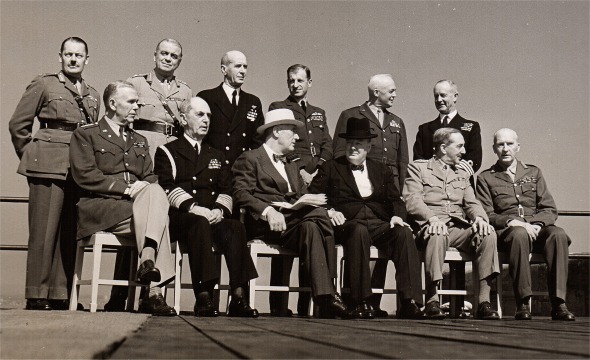
Top Men at Quebec
The President of the United States and the Prime Minister
of Great Britain together with combined Chiefs of Staff pose for photographers
on the Terrace of the Citadel at the conclusion of their joint conferences
in Quebec. Seated, left to right, are: General G.C. Marshall, Admiral W.D.
Leahy, the President, the Prime Minister, Field Marshall Sir Alan Brooke,
Field Marshall Sir John Dill. Standing at the back, from left to right
are: Major General J. Hollis, General Sir Hastings L. Lamay, Admiral E.J.
King, Marshal of the RAF Sir Charles Portal, General H.H. Arnold, Admiral
of the Fleet Sir Andrew B. Cunningham.

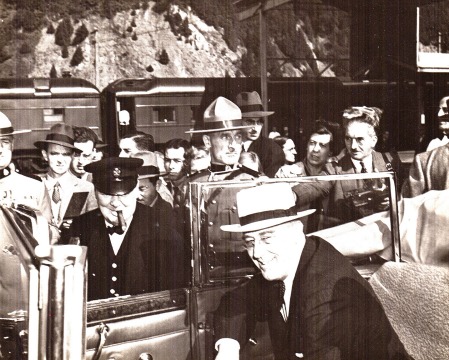
US President Franklin D. Roosevelt
. . . in his Presidential Automobile with Britain's Prime
Minister Winston Churchill astride the car, at the Quebec City train station.

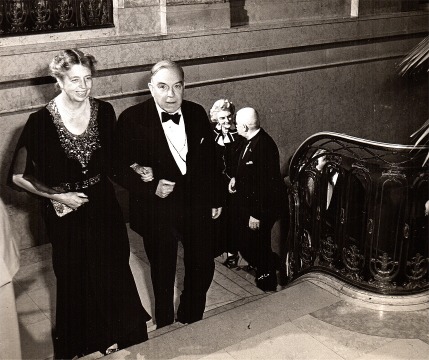
The Prime Minister's Reception
Following their guests up the broad sweep of the marble stairs
at the Chateau Frontenac the Prime Minister and Mrs. Roosevelt, followed
by Mrs. Churchill and the Lieft-Governor of Quebec, Sir Eugene Fiset, proceed
to the banquet hall, where they sat with more than 300 quests who attended
the Prime Minister's reception.

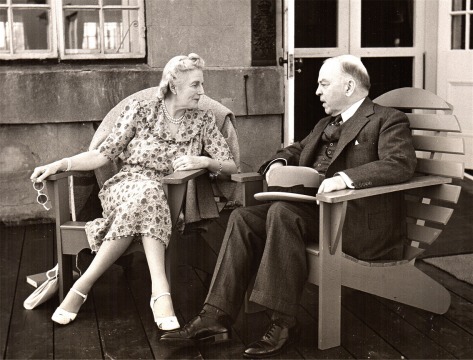
A Quiet Chat
Seated on the terrace at the Citadel overlooking the broad
sweep of the St. Lawrence below, Mrs. Churchill, wife of the British Prime
Minister, chats with Canada's Prime Minister as the two await the rest
of the party before meeting a battery of press and movie photographers.
A vigilant National Film Board photographer caught this exclusive photo.

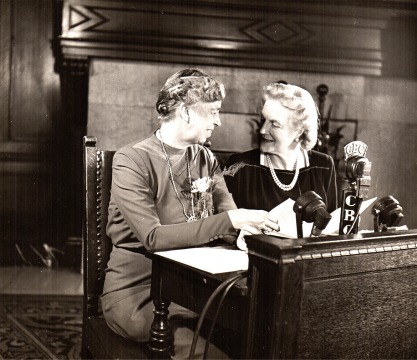
On The Air
Speaking to the Canadian people over the CBC network, Elanor
Roosevelt and Mrs. Churchill chat together for photographers before they
deliver their messages. They spoke from the radio room of the CBC at the
Chateau Frontenac Wednesday evening, just before attending the reception
of Canada's Prime Minister there.

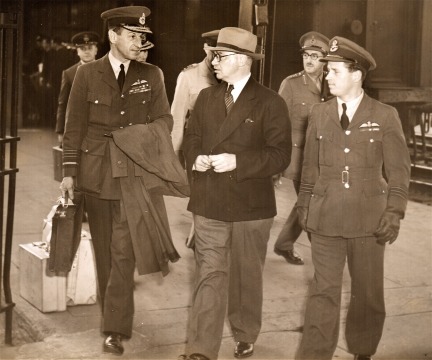
L-R: Air Chief Marshall Sir Charles Portal, (Minister
of Defence for Air) Air Marshal
C.G. Power, General Sir Alan Brooke, Wing Commander
Gibson.

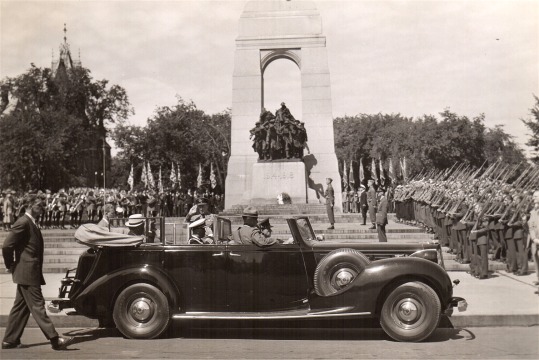
President Franklin D. Roosevelt in Presidential automobile
passing the Cenotaph in Ottawa.
(There is no record that FDR visited Ottawa before
or after the 1944 conference.
He did visit Ottawa in 1943 after the first Quebec
Conference and this photo must be of that event.)

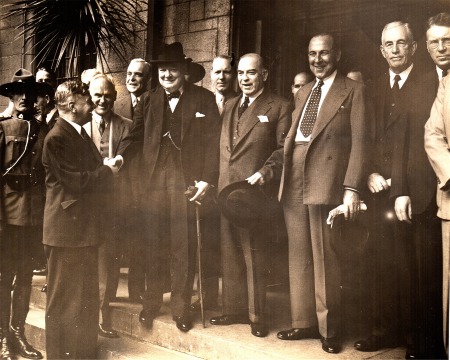
Winston Churchill and W.L. Mackenzie King
with Royal Canadian Mounted Police and gentlemen.
(4)

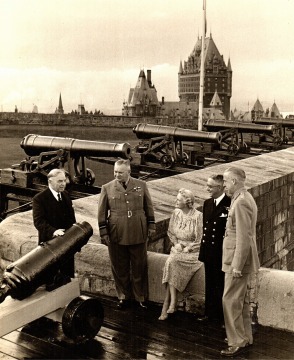
Prime Minister William Lyon Mackenzie King,
RCAF Air Chief Marshall Breadner and
Clementine Churchill at the Citadelle in Quebec City.

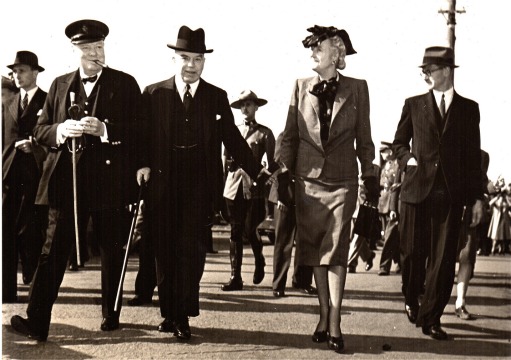
Old Friends Meet Again
First to greet the British Prime Minister on his arrival
in Quebec City for the Second Quebec Conference was Canada's Prime Minister
W.L. Mackenzie King, who boarded the Churchill train as it came to a stop,
welcomed Mr. and Mrs. Churchill to Canada. Then all three walked over to
the automobile of the United States President on an adjacent siding, and
the entire party proceeded to the Citadel, where they are guests of His
Excellency the Governor General and Her Highness Princess Alice during
the duration of the Conference. Photo shows Winston Churchill, Mr. King
and Mrs. Churchill as they proceed to greet the President.

Copyright 2013. Greg Sigurdson. All
Rights Reserved.
025 of
150
A World War II Memory: Cliff Shirley - Air Observer/Navigator
The following oral history was received
at the Commonwealth Air Training Plan museum in June 2001. In the letter
dated January 20 2001 that accompanied the donation, a man by the name
of Willie Freitag explained that Cliff Shirley, the author of the oral
history, met him while teaching Willie’s younger brothers in the school
in Alameda Saskatchewan. He said that Cliff taught school for four years
before joining the Royal Canadian Air Force in 1940 and was now 87 years
old and as sharp as he was 60 years ago. When Willie told Cliff that the
museum was looking for `war stories,’ Cliff wrote his oral history which
he sent to Willie who then sent it to us.
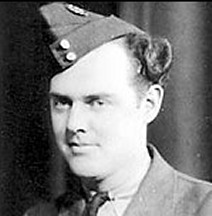 Willie,
Willie,
I'd like to comply with your request for comments about
air force during World War by telling of several learning experiences.
I have nothing but praise for what the British Commonwealth Air Training
Plan (B.CATP) did for me. I graduated with an "Air Observer's Wing" (an
"O" ). The air observer course specialized in Navigation and Bombing with
a smattering of Gunnery, Wireless and Meteorology in stages of about sixteen
weeks each.
Prime Minister MacKenzie King demanded that control of
the training plan in Canada be administered by the Canadian government
and its Canadian graduates would maintain their Canadian identity when
sent overseas. The deal was made on MacKenzie King's birthday December
17/39. I still say congratulations to our former prime minister for that
memorable
agreement.
In the British Air Manuals, the Canadian Air Observer's
training for the handling of a responsible and exacting task, are commended.
About 1942 Commander Harris decided that Air Observer (0) be changed to
Air Navigator (N) because the task of navigation did not give the eyes
of the navigator time to adjust over the target to use the bomb sight accurately.
I think bombing was my favorite and a very successful part of our training,
but later, when new instruments were added to our job, I understood Commander
Harris' thinking. The organization by BCATP was superb--it almost seemed
our name was on our bunk before we arrived and our plate at a table was
waiting to be filled with good food .
During our training we moved about six times and had to
pass many tests in the air and at a desk. To tell the complete truth--the
best classroom we had was the inside of a bomber; the most useful information
we had was from the airmen who had just returned from a bombing raid. To
pass all air and ground tests gave our pride a big boost. To look at our
insignia gave us a feeling that we could succeed at any job in this new
career. In fact, we didn't know what fear was and acted quite "cocky.’’
Next came a posting to an operational training unit in
Yorkshire, England. What a difference -- larger and faster aircraft (Wellingtons),
a crowded and hostile air space and flying at night with little or no visibility
of the ground (everything was completely blacked out). The training was
quite concentrated and chatter among our airmen involved a bit of casual
bravado (to me that word means "fear"). At the end of this course, we were
sent to a crewing-up arena or posted to squadrons.
As for me, I saw two uniformed men approaching. The one
with the Wings (a pilot) said "We need a Navigator-Bomb aimer", the one
with the half wing (a wireless op) said "Our first Navigator was a "clot"·
Wow -- my imagination was my enemy, but I was on my way to membership in
a real RAF air crew on an RAF station in operational Manchester bombers.
These bombers had the reputation for not performing too well at high level
- with a heavy load of explosives. The air crew bonded well, the ground
crew were talented and all had very visible cheerful expressions. Our pilot
turned out to be a superman (we called him "Flash"). Most of our bombing
was done between two and four thousand feet and I learned to like to use
the bomb sight. All our trips were at night in a dark and hostile sky,
At the end of the first tour (30 trips) I was posted to
a test crew job. The crew was RAF, Our tasks were challenging but not too
risky. Many of the results were quite useable. In fact, we were treated
as sort of "gen" men flying a radial engine Lancaster bomber. Our pilot's
name was King Cole and he could play the part with gusty bravado using
a cockney accent. To be quite honest, I liked the "King" and he was a talented
pilot and captain. I learned a lot about navigation during this six months
and what I learned served us well; but – I ran into a problem.
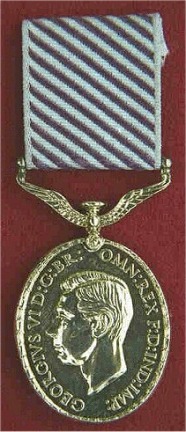 With
success and experience came a promotion. I now moved to the British Officer's
area. When a young man brought up in a friendly farm environment in Saskatchewan
tries to adjust his culture to that practised by British officers, somebody
is going to be unhappy. I soon understood why MacKenzie King said Canadian
air men would keep their own identity. I couldn't understand how Royalty
could inspire men to be arrogant and haughty; I couldn't understand how
a rural Saskatchewan school teacher should be regarded as "dim, daft, and
difficult". I had chosen freely to join the RAF, and I proudly kept my
accent, vocabulary and behaviors. Time cures most problems, and I have
to concede that RAF airmen and ground crews were trained very well and
made determined efforts to hit their targets!
With
success and experience came a promotion. I now moved to the British Officer's
area. When a young man brought up in a friendly farm environment in Saskatchewan
tries to adjust his culture to that practised by British officers, somebody
is going to be unhappy. I soon understood why MacKenzie King said Canadian
air men would keep their own identity. I couldn't understand how Royalty
could inspire men to be arrogant and haughty; I couldn't understand how
a rural Saskatchewan school teacher should be regarded as "dim, daft, and
difficult". I had chosen freely to join the RAF, and I proudly kept my
accent, vocabulary and behaviors. Time cures most problems, and I have
to concede that RAF airmen and ground crews were trained very well and
made determined efforts to hit their targets!
We did our second tour in Lancaster Bombers at from 15,000
to 20,000 feet. We. (Flash and crew) did our share of Ruhr Valley bombing
and mine laying trips. We had one interesting trip when we bombed near
the toe of Italy, landed in Africa and bombed a city in northern Italy
on the way home. This seven hour trip was quite different to others.
English Commander Harris believed in concentrated bombing
of bombers in a short period of time, with a very large number of German
fighters who were dedicated and well trained; their air craft were almost
equal to Spitfires. Sometimes they entered our circuit when we were landing
or at takeoff.
The next line is hard to write. Good bye to our pilot
(Flash ). He was killed four days after completion of our second tour.
If God needed a talented, gifted and dedicated Englishman, his choice was
perfect, but heart breaking. I still ride my Raleigh bicycle that he liked
to borrow. I learned a lot from my ``hero".
Next came a posting to the BCATP at Rivers, Manitoba .
This course included instructional techniques, navigation and searches.
At the conclusion of this course we (my wife and I) went to Overseas Training
Unit at Boundary Bay, B.C., interacting and flying in Mitchells and Liberators.
Flying in friendly skies and unfriendly mountain peaks was a big change.
The students were mostly men who had completed one or more tours in the
European war and were crewed up
in preparation for Japan.
I can't say I enjoyed searches for airmen who didn't return
from flying over dangerous terrain. Most of our searches were failures.
I didn't look forward to what was to be bombing in the Asian area . I had
no regrets when peace was declared on Aug 14, 1945. If when reading the
honour rolls of Arcola-Kisbey and Carlyle, I think these districts in Sask.
lost more than their share of uniformed men.
To go from BCATP as a student and to return to BCATP as
an instructor requires a little luck. Whether we call it luck, or that
someone had me by the hand, or that BCATP did its job--I say this: Willie,
there's a silent "thanks" in every line I write. Writing the whole thing
brings back many sad memories. It's too cruel to believe that civilized
nations have to resort to war to settle arguments. The next conflict will
have weapons that could shake planet "Earth", but I am sure it will never
happen.
When we (my wife and family) went to teach school in Redvers,
one of the first men I met was Chris Sutter. He had an experience where
air space was very crowded. He is the sole survivor from two four engine
bombers that collided over enemy territory. He made a successful parachute
landing and in spite of a sore back, I am sure this airman also says a
few "thanks" and has many memories.
Willie,--I don't think there will be a volume two. I taught
school for many years. I hope the World War improved my abilities as a
teacher. I taught many wonderful school students. They were always good
to me. Those years I wish I could repeat.
Cliff Shirley
Weyburn Saskatchewan
Citation for the award of Cliff Shirley’s Distinguished
Flying Medal (from Hugh Halliday’s RCAF Honours and Awards database):
SHIRLEY, FS (now WO) Clifford Alvin (R79864) - Distinguished
Flying Medal - No.158 Squadron - Award effective 31 December 1942 as per
London Gazette dated 12 January 1943 and AFRO 232/43 dated 12 February
1943. Born in Carlyle, Saskatchewan, 1912; home there or in Ladner,
British Columbia (teacher); enlisted in Regina, 28 November 1940.
Trained at No.2 ITS (graduated 31 March 1941), No.3 AOS (graduated 23 June
1941), No.2 BGS (graduated 4 August 1941) and No.1 ANS (graduated 1 September
1941). Commissioned 1942. Invested with award by King George VI,
16 March 1943.
Flight Sergeant Shirley, as navigator, has
participated in many attacks on important targets in the Ruhr and the Rhineland.
He also took part in two of the attacks on Rostock, all three 1,000 bomber
raids on Cologne, the Ruhr, and Bremen, the highly successful attacks on
Genoa and the daylight raid on Milan. His standard of navigation
has invariably been of the highest order.
Throughout, this airman's conduct and determination
has set a fine example both in the air and on the ground.
Cliff died on May 12 2005 at the age of 92 years. Cliff’s
complete obituary can be seen at:
http://www.legacy.com/obituaries/leaderpost/obituary.aspx?n=clifford-alvin-shirley&pid=3540509
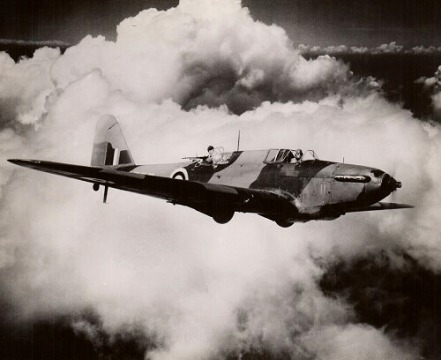 .
.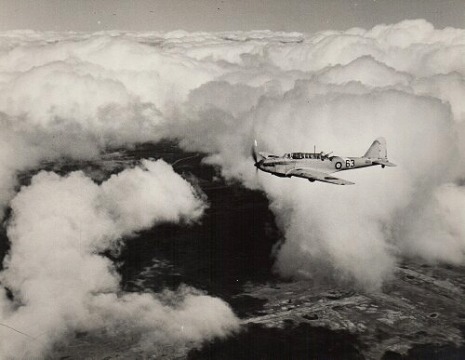
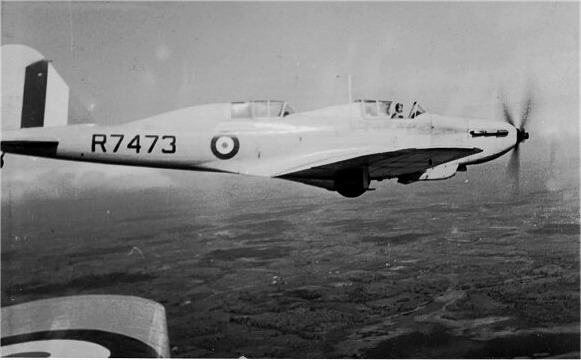 .
.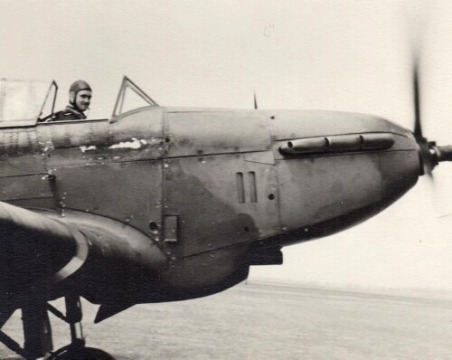 .
.
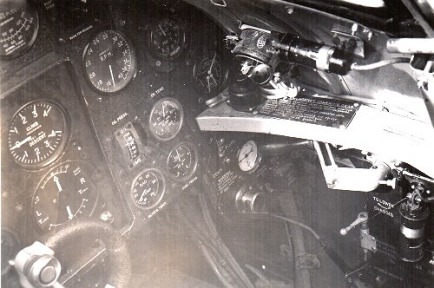 .
.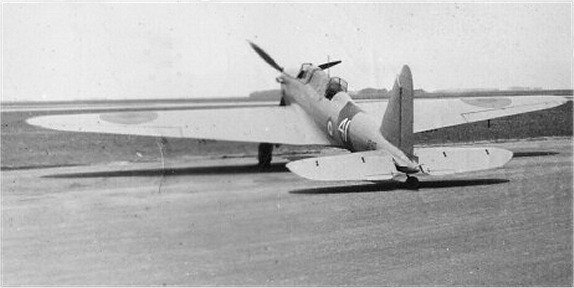 .
.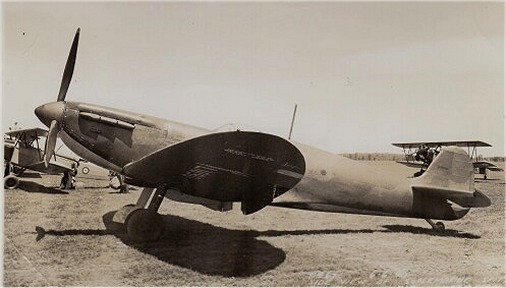
 A
wonderful newspaper article in Britain’s The Mail on Sunday was brought
to our attention by Commonwealth Air Training Plan Museum charter member
John Robinson. It is the story of Mary Ellis, a veteran of the World War
II’s Air Transport Auxiliary, who celebrated her 100th birthday earlier
this year. The Mail on Sunday relayed her story and a video of her taking
control of a Spitfire aircraft, flying in formation with one she had flown
in WWII, over West Sussex in October of 2016. The complete story can be
seen at:
A
wonderful newspaper article in Britain’s The Mail on Sunday was brought
to our attention by Commonwealth Air Training Plan Museum charter member
John Robinson. It is the story of Mary Ellis, a veteran of the World War
II’s Air Transport Auxiliary, who celebrated her 100th birthday earlier
this year. The Mail on Sunday relayed her story and a video of her taking
control of a Spitfire aircraft, flying in formation with one she had flown
in WWII, over West Sussex in October of 2016. The complete story can be
seen at:
 In
1836, Samuel Morse, an American, introduced the code system which bears
his name, and the first message by using the "Morse Code" was sent by telegraph
from Washington to Baltimore in 1844. The introduction of the Morse Code
was a tremendous advance in signalling, since it meant that communication
was no longer restricted to persons within sight of each other, but messages
could now be sent day or night over long distances. Although the code invented
by Morse was satisfactory for telegraph work certain difficulties were
encountered with the rapid: advance of radio or wireless telegraph as it
was called and at a convention in London in 1912 a new code was introduced,
known as the "International Morse Code". This covers all the languages
that use the Roman alphabet-English, French, German, Spanish, etc. The
"International Morse Code" is the code used in the R.C.A.F. for signalling
by means of wireless telegraphy. The international Morse Code can also
be used to signal by visual means (Aldis lamps) and by sound (Klaxon horns
for use in fog).
In
1836, Samuel Morse, an American, introduced the code system which bears
his name, and the first message by using the "Morse Code" was sent by telegraph
from Washington to Baltimore in 1844. The introduction of the Morse Code
was a tremendous advance in signalling, since it meant that communication
was no longer restricted to persons within sight of each other, but messages
could now be sent day or night over long distances. Although the code invented
by Morse was satisfactory for telegraph work certain difficulties were
encountered with the rapid: advance of radio or wireless telegraph as it
was called and at a convention in London in 1912 a new code was introduced,
known as the "International Morse Code". This covers all the languages
that use the Roman alphabet-English, French, German, Spanish, etc. The
"International Morse Code" is the code used in the R.C.A.F. for signalling
by means of wireless telegraphy. The international Morse Code can also
be used to signal by visual means (Aldis lamps) and by sound (Klaxon horns
for use in fog).










 Willie,
Willie,
 With
success and experience came a promotion. I now moved to the British Officer's
area. When a young man brought up in a friendly farm environment in Saskatchewan
tries to adjust his culture to that practised by British officers, somebody
is going to be unhappy. I soon understood why MacKenzie King said Canadian
air men would keep their own identity. I couldn't understand how Royalty
could inspire men to be arrogant and haughty; I couldn't understand how
a rural Saskatchewan school teacher should be regarded as "dim, daft, and
difficult". I had chosen freely to join the RAF, and I proudly kept my
accent, vocabulary and behaviors. Time cures most problems, and I have
to concede that RAF airmen and ground crews were trained very well and
made determined efforts to hit their targets!
With
success and experience came a promotion. I now moved to the British Officer's
area. When a young man brought up in a friendly farm environment in Saskatchewan
tries to adjust his culture to that practised by British officers, somebody
is going to be unhappy. I soon understood why MacKenzie King said Canadian
air men would keep their own identity. I couldn't understand how Royalty
could inspire men to be arrogant and haughty; I couldn't understand how
a rural Saskatchewan school teacher should be regarded as "dim, daft, and
difficult". I had chosen freely to join the RAF, and I proudly kept my
accent, vocabulary and behaviors. Time cures most problems, and I have
to concede that RAF airmen and ground crews were trained very well and
made determined efforts to hit their targets!
